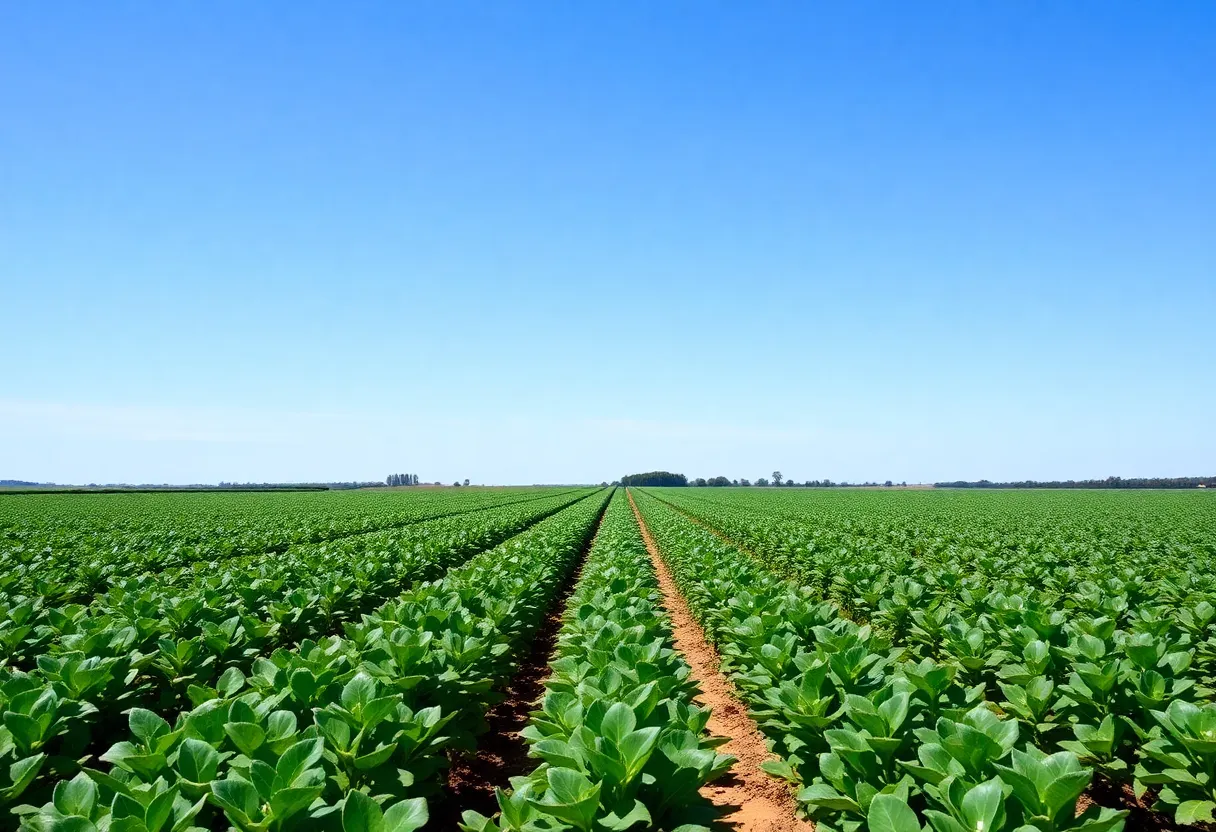Washington, D.C., October 31, 2025
U.S. soybean farmers are optimistic following a new agreement with China, which commits to purchasing 25 million metric tons of soybeans annually over the next three years. This deal aims to restore trade balances disrupted by previous tensions. While the agreement provides immediate relief with an initial purchase of 12 million metric tons, farmers remain cautious due to high operating costs and past inconsistencies in trade commitments. Analysts suggest the agreement could stabilize rural economies but emphasize the need for reliable, long-term trade solutions.
Washington, D.C.
U.S. Soybean Farmers Celebrate Major Trade Boost with China
New Agreement Promises 25 Million Metric Tons of Soybeans Annually
U.S. soybean farmers have received a significant boost following China’s commitment to purchase 25 million metric tons of American soybeans annually over the next three years. This milestone agreement strives to restore the trade levels to those seen prior to the U.S.-China trade tensions that grew during the previous administration, highlighting the dynamic nature of international trade and its impacts on local economies.
The deal includes an initial purchase of 12 million metric tons of soybeans by January, delivering immediate relief to farmers who have recently contended with geopolitical challenges affecting their trade. Additionally, China’s decision to remove retaliatory tariffs on U.S. agricultural products and to resume purchases of sorghum further supports the resilience of the agricultural sector.
Impact of the Agreement on Farmers
Despite the encouraging news, it is important to recognize that farmers remain cautious regarding the sustainability of these agreements. The deal, while a positive step forward, does not completely mitigate the difficulties they face, including rising input costs for essential items such as fertilizer, seeds, and machinery repairs. The atmosphere of uncertainty is palpable, especially given previous instances where trade commitments from China were not fully honored during turbulent periods like the COVID-19 pandemic.
Analyzing the Broader Implications
Economists and analysts view this agreement as a well-calculated move designed to stabilize rural communities and invigorate the agricultural sector. They underscore that while immediate financial relief is beneficial, the foundation for sustainable growth lies in establishing reliable, long-term agreements. Comprehensive trade solutions are vital to address the ongoing trade deficits and core issues that significantly influence the agricultural industry’s performance.
Key Features of the Agreement
| Feature | Description |
|---|---|
| Annual Purchase Volume | 25 million metric tons of U.S. soybeans over the next three years |
| Initial Purchase | 12 million metric tons to be completed by January |
| Tariff Adjustments | Removal of retaliatory tariffs on U.S. agricultural products |
| Additional Purchases | Resumption of sorghum purchases by China |
| Farmer Concerns | High input costs and concerns about China’s commitment to the agreement |
Conclusion
In summary, the recent agreement between the U.S. and China represents a pivotal moment for U.S. soybean farmers, providing a crucial market opportunity while addressing some immediate trade barriers. However, the agricultural community remains vigilant, recognizing that lasting solutions are essential to navigate complexities in trade relationships. Encouragingly, this deal embodies the entrepreneurial spirit and resilience that defines American farmers. As local businesses and agricultural sectors work towards recovery, it is important for communities to stay engaged with the economic developments that shape their futures.
Readers are encouraged to support local businesses and advocate for policies that enhance trade stability and agricultural innovation in New York and beyond.
Frequently Asked Questions (FAQ)
What is the recent agreement between the U.S. and China regarding soybeans?
The U.S. and China have agreed that China will purchase 25 million metric tons of U.S. soybeans annually over the next three years, with an initial purchase of 12 million metric tons to be completed by January. This agreement aims to restore trade levels to those seen before the U.S.-China trade tensions escalated during the previous administration.
How does this agreement impact U.S. soybean farmers?
The agreement provides immediate relief to U.S. soybean farmers by securing a significant market for their products. It also includes the removal of retaliatory tariffs on U.S. agricultural products and the resumption of sorghum purchases by China, further supporting the agricultural sector.
Are there any concerns associated with this agreement?
Despite the positive developments, farmers remain cautious. The agreement does not address all the challenges they face, such as high input costs for fertilizer, seeds, and machinery repairs. Additionally, there are concerns about China’s commitment to follow through on the agreement, given past instances where trade promises were disrupted, notably during the COVID-19 pandemic.
What do analysts say about the agreement?
Analysts interpret the deal as a strategic move to benefit rural communities and stabilize the agricultural sector. However, they emphasize the need for reliable, long-term agreements to ensure sustained support for American farmers. The situation underscores the importance of comprehensive trade solutions to address the core issues and trade deficits affecting the agricultural industry.
Now Happening on X
- @izurietavarea (October 31, 2025): New York is undergoing a process of definancialization, with fewer new jobs in finance compared to years past, and replacements mainly in healthcare and social assistance. View on X
- @yankeefina87656 (October 29, 2025): Contrary to some narratives, New York City’s real estate market is thriving with zero vacancy rates, record-high rents, booming offices, packed hotels and restaurants, and high-end condos selling at premium prices. View on X
- @Cobyvu8820 (October 28, 2025): New York’s venture capital scene shows a polarized trend in Q3 2025, with $608 million invested across 391 deals—a 5% capital increase but the lowest deal count since early 2024. View on X
- @bizfacilities (October 28, 2025): New York is making strong gains in both domestic and international markets, leveraging its inherent strengths in business and economic development. View on X
- @DerrickSalas9 (October 28, 2025): Israeli-founded firms in New York are driving significant economic impact, creating about 30,000 direct jobs and contributing $12.4 billion, highlighting ties in tech and defense sectors. View on X
- @elle_kaye11 (October 27, 2025): New York City has only added about 6,000 new jobs this year—mostly in nonprofits—far below the typical 200,000, while 56 investment banks have left, signaling economic trouble. View on X
- @MikeMaxAlabama (October 27, 2025): The financial services sector in New York City, a key taxpayer and employer, has shrunk by 8,400 jobs from January through August, accelerating an exodus from the state. View on X
- @elle_kaye11 (October 25, 2025): With job growth lagging and major financial players departing, New York’s economy faces challenges from an exodus of money, second only to California in the U.S. View on X
Deeper Dive: News & Info About This Topic
HERE Resources
Author: STAFF HERE NEW YORK WRITER
The NEW YORK STAFF WRITER represents the experienced team at HERENewYork.com, your go-to source for actionable local news and information in New York, the five boroughs, and beyond. Specializing in "news you can use," we cover essential topics like product reviews for personal and business needs, local business directories, politics, real estate trends, neighborhood insights, and state news affecting the area—with deep expertise drawn from years of dedicated reporting and strong community input, including local press releases and business updates. We deliver top reporting on high-value events such as New York Fashion Week, Macy's Thanksgiving Day Parade, and Tribeca Film Festival. Our coverage extends to key organizations like the Greater New York Chamber of Commerce and United Way of New York, plus leading businesses in finance and media that power the local economy such as JPMorgan Chase, Goldman Sachs, and Bloomberg. As part of the broader HERE network, including HEREBuffalo.com, we provide comprehensive, credible insights into New York's dynamic landscape.





